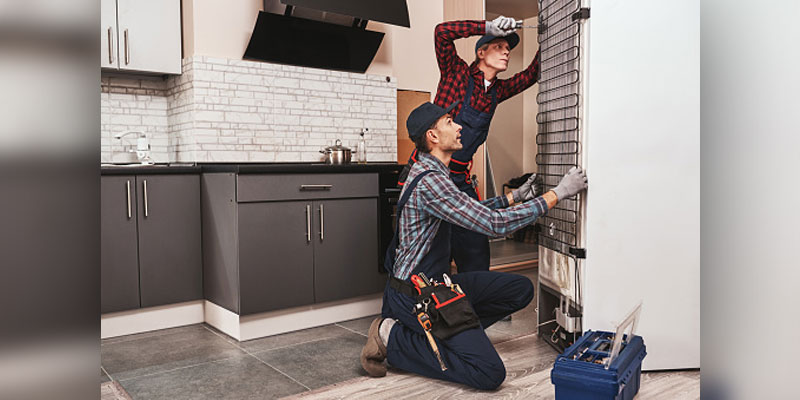Refrigerators run day and night without rest for the whole year. At times, negligence in maintenance and servicing may fail to chill the foodstuff. There are ample reasons for refrigerators not cooling. Troubleshooting the reasons for refrigerators not cooling is effortless as they are a few main reasons that lead to less cooling. Rectifying the above issue has also become a doddle with good technical knowledge.
Hence, check out the reasons given below and narrow down to the target reason for coolness failure in the refrigerator to solve issues instantly. Below are a few reasons for refrigerators not cooling and ways to overcome them. Try these ways and solve the refrigerator hassle effortlessly.
1. Dusty condenser coils
Condenser coils reside behind the refrigerator, and their main task is cooling and condensing the refrigerant. These condenser coils aren’t in a sealed unit, and subsequently, dirt and dust gather over these coils. With abundant caked dust, heat release faces hindrance and drives into the refrigerator, failing to cool.
Go for a specific refrigerator coil brush, or use the vacuum cleaner to get rid of the debris. Make a schedule for cleaning the refrigerator coils once or twice a year for proper cooling.
2. Incorrect temperature setting
The temperature controls are the primary aspect to check during less cooling in any refrigerator. The temperature controls may be altered by children or changed mistakenly. Therefore, checking the temperature controls before calling a technician is wise to solve refrigerator issues.
Resolve incorrect temperature issues by turning the thermostat to the required temperature. Few refrigerators possess separate controls for refrigerators and freezers and hence change accordingly. Do not expect chillness instantly after correcting temperature controls, as it may take a day.
3. Dust accumulated door gaskets
The refrigerator door possesses sealing property and adds to the better cooling property. As the years pass, users’ fingerprints, food items, and dust accumulate over these gaskets, damaging their sealing property. Such gasket errors are another primary reason for refrigerators not cooling effectively.
Wiping the gasket-related areas with warm soapy water work wonders to end errors. A good piece of advice is to avert the use of window cleaning sprays, scrubs, abrasive cleaners, brushes, and more.
4. Food items obstruct the air vents.
The refrigerator always holds large bags and boxes of food items. Check if such bulk of items blocks the air vents resulting in less cooling. Positioning large bags and boxes in front of the vents prevents cool air from invading the refrigerator unit.
Plan and relocate large bags and food boxes to the refrigerator. Ensure that the air vents are free without blockage for better cooling.
5. Improper or no electric supply
If the refrigerator fails to work even after an appropriate power supply, there could be an error in the power supply or no electric supply. Test the power socket with another electric appliance to know if the power flows without disturbances. If the appliance works, there isn’t a problem with the power supply, and technicians need to attend to the refrigerator.
If the power supply doesn’t work, the main task is correcting the power socket for electrical issues and paving the way for the refrigerator to work. In such scenarios, identifying the power issue and rectifying it helps the proper cooling of the fridge.
6. Damaged evaporator fan
The main responsibility of an evaporator fan is driving in chill air from evaporator coils into the refrigerator unit. Suppose the evaporator fan breaks, and the cool air circulation into the unit is disturbed. It’s now time to check and replace the evaporator fan.
Check for a warranty to replace the evaporator fan, and also bear in mind that good mechanical knowledge is mandatory for replacing the evaporator fan.
7. Thermostat issues
The thermostat is one of the most important parts of a refrigerator. A faulty or broken thermostat may result in the malfunction of the refrigerator. Temperature-associated issues arise due to hassles with the thermostat. A thermostat ceases to work due to human error, accumulation of dirt, long life span, etc. Check the settings in the thermostat and set it right for proper working. Another cheap and wise way is to replace the thermostat for better cooling in the refrigerator. Proper research, knowledge, and appropriate tools for replacing the thermostat are a cakewalk.
8. Compressor issues
A defective compressor with a start relay could be the issue for the refrigerator not cooling. However, the main task of a compressor is compressing and pushing refrigerant vapor into the coils. The compressor operation is responsible for absorbing heat from the refrigerator and freezer and cooling it. Cases where the refrigerator doesn’t cool even when the freezer fan runs could be an issue with the compressor start relay.
A good way to solve the above issue is by replacing the compressor start relay. It would be great to purchase a new starter relay and test with the compressor to confirm the issue is with the compressor start relay.
9. Following clearance guidelines
A good cooling effect in the refrigerator depends on the appropriate clearance on the sides and back of the refrigerator. Read the guidelines and follow the same for clearances and place accordingly for better operation and cooling of the refrigerator.
Thorough checking of all the above factors helps you identify the fault in the refrigerator cooling issue. But detecting refrigerator issues for not cooling is tricky and mandates specific electrical equipment at times. A technician is well aware of the issues and identifies them quickly. When nothing works, seeking the assistance of a refrigerator technician is the best way.
If Everything Else Fails, Hire a Professional Technician
Holding hands with a refrigerator technician is a perfect way to flawlessly solve the refrigerator cooling issue. When things go wrong, and individuals possess very little electrical knowledge, associating with professionals works wonders. Technicians have years of experience, and they know the right source that causes the issue. Technicians also follow the right protocol and solve the hassle precisely. Nail the solution easily by troubleshooting.


